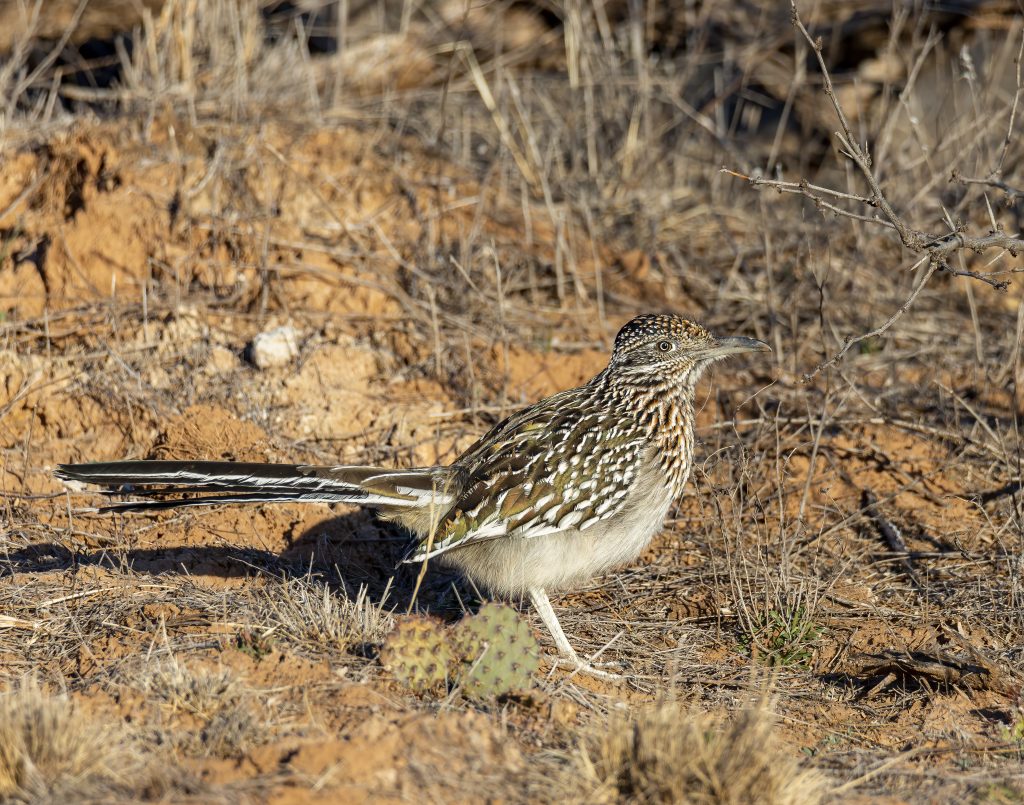
One of the most well-known birds in North America, the roadrunner was an iconic symbol to humans long before the animated antics of Looney Tunes brought them into mainstream popularity.
Hopi and Pueblo tribes revered roadrunners as medicine birds that could ward off malicious spirits with their unique X-shaped footprints made by their zygodactyl feet (meaning they have two toes in front and two in the back). These prints make it impossible to tell which direction the bird travels, thus confusing any would-be spiritual attackers. The speed of roadrunners and their bravery in devouring rattlesnakes further added to their high regard among native peoples.
With these characteristics, the roadrunner was an ideal candidate for the cast of Looney Tunes, although Warner Brothers took several creative liberties in their depictions. Coyotes are a predator of roadrunners but wouldn’t have to resort to rockets and traps to catch one in real life. Roadrunners can easily outrun most humans with their top speed of 20 mph but coyotes can run twice as fast. Good thing roadrunners have no problem flying when they need to escape danger—they just prefer ground transportation most of the time.
The call of a roadrunner is a far cry from the “beep beep” of its animated counterpart; in reality they make a soft, dove-like “coo” call and will use its beak to make a rapid clattering sound. The origin of the animated roadrunner’s taunt originated with a background painter at Warner Brothers who would call out “beep beep” while carrying large canvases through hallways on set, and, unable to see in front of him, warned people to get out of the way.
This isn’t to say that real-world roadrunners are any less remarkable. They’ve adapted to harsh desert climates through thermoregulation techniques, such as secreting concentrated salt through a gland in front of each eye, which conserves more water than if they excreted liquid through urination. On hot days, they flutter the unfeathered area beneath their chin to cool down, and on cold nights they enter a state of torpor, lowering their heart rate and metabolism to the minimum needed for survival, to retain heat.
What little moisture they consume comes primarily from the blood of their prey. Opportunistic carnivores, roadrunners will eat anything that crawls or slithers along the ground. From insects like beetles and spiders, reptiles like snakes and lizards, to even tarantulas and smaller birds, they’re not picky when it comes to supper. The roadrunner is not intimidated by the scorpion’s stinger or the fang of a rattlesnake, even though they don’t have immunity to the deadly venom. Roadrunners risk life and wing for a meal on a regular basis and are the only known predators of the tarantula hawk wasp, an insect with the most painful sting in the world.
When they’re not doing battle with these most dangerous reptiles and insects of the desert, the roadrunner can be found with its partner raising their young together. They’re monogamous and can mate for life, with both parents taking turns feeding the young and protecting the nest. A male roadrunner will attract a female with a courtship display and by offering a gift like a tasty morsel of food. Once the hatchlings are three weeks old, the family will forage for food together until their offspring go off on their own.
Roadrunners are uncommonly common in New Mexico. You can hike around their territory for hours without seeing one, then one may pop up in your driveway when you get home. They’re not typically found in the northern reaches of the state, but it isn’t unheard of for a lucky birdwatcher to spot one dashing through the sage. Roadrunners are known in ornithological circles as being the bird most comfortable around humans. Considering they consume lethal prey for breakfast, it’s not surprising that people don’t scare them!
1 http://www.native-languages.org/legends-roadrunner.htm
2 https://www.nhm.ac.uk/discover/the-most-painful-wasp-sting-in-the-world-explained.html
3 https://tucson.com/news/local/what-roadrunners-humans-have-in-common/article_159a3c13-e94f-548c-8873-08f3d42de790.html
Author
-

Bryce Flanagan moved from Sacramento, CA to Taos County in 2016, and has lived in Questa for two years. He's passionate about the unique and beautiful wildlife of our state and is a regular contributor to the Questa Del Rio News.
View all posts


